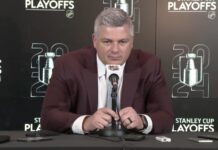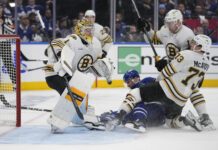Now that we’ve had a few days to digest the acquisition of future Hall of Famer Patrick Marleau, let’s take a look at the situational strengths and weaknesses of the new Toronto Maple Leafs winger and where he could fit into the team’s lineup.
To get a better sense of Patrick Marleau’s role in San Jose, I enlisted the help of Erik Johnsgard, a staff writer at the excellent Sharks website, Fear The Fin.
Emergency Center Option
When’s the last time Marleau played center for a significant run of games?
Johnsgard: He played a fair amount at center in 2015-16, when Couture was out with his broken fibula, but before that I think he played primarily on the wing since 2010 or so. During the early aughts, though, he played a lot of center, but when Thornton came into the picture in 2005 the team started to back away from it.
As Erik mentions above, in October of 2015, Logan Couture broke his leg and missed nearly two months. During that time, if we assume Marleau was at center for the majority of the 23 games Couture was out, here were his numbers while filling in down the middle: In over 20 minutes a night, he scored eight goals and 16 points, and posted a 51% Corsi For as well as a 52% share of the high-danger scoring chances. However, he was a minus-eight in those games, with just a 41% Goals For Percentage.
Marleau also covered at center for a handful of games when Couture took a puck to the face late in the 2016-17 season and he was asked about filling in at C:
“I don’t think there’s been a year where I haven’t played center, so it’s just one of those things, move in and out. We’re interchangeable throughout the whole lineup, anyway.”
He’s certainly best used as a winger, but he adds a credible center option if a disaster was to strike with injuries. With Auston Matthews, Nazem Kadri, Tyler Bozak, the newly acquired Dominic Moore, William Nylander and Marleau (and Leo Komarov can be thrown in here, as well) all capable of playing in the middle, it will be a far cry from the days of Trevor Smith at 2C, signing Jerred Smithson mid-season out of desperation, or experimenting with James van Riemsdyk (JVR) at center.
Also worth mentioning here is Marleau’s faceoff ability — he’s a career 51.3%, and just had his best ever year on the dot last season, winning 53.7% of 215 faceoffs. With the draw being a strength of Tyler Bozak’s and an improving facet of Nazem Kadri’s game (he was a 45.1% in his first five years in the league, and has improved to a 48.6% in his last two years under Babcock), that would add another check in the pro column in favour of playing Marleau on Matthews’ left wing in the eyes of Babcock. Sharks centerman Logan Couture is a poor faceoff man – he was at 39% last season – and Marleau would take the draws on nights when Couture was struggling if they were on a line together. It adds some insulation for the faceoff circle as Matthews develops that facet of his game.
Special Teams
What was his role on the power play?
Johnsgard: Marleau’s a pretty consistent performer on the power play, he tends to like to camp out on the right side of the net, either to pick up rebounds or retrieve pucks out of the corner. A lot of his power play goals over the years have been cashing in on rebounds or deflections. He doesn’t get as much credit for tips here in Joe Pavelski’s shadow, but he’s opportunistic. He will occasionally post up to the right point when Burns goes wandering, but over the last decade or so he hasn’t had a lot of net front presence unless Pavelski was out for whatever reason, and not a lot of half wall time unless Thornton was out.
Going by Marleau’s highlight clips, he’s effective in the slot position on the power play. He’s masterful at tips and redirections, he’s adept at picking up rebounds, he’s heavy on his stick, and he can get the puck on and off his stick in a hurry in tight spaces. It’s not hard to picture Marleau thriving as the slot guy/decoy in the middle of Jim Hiller’s power play setup, as Nazem Kadri did last season (12 PP goals, tied for eighth in the league). We could see one unit of Matthews – Marleau – Nylander, with Komarov at net front, and another unit of Kadri – Bozak – Marner, with JVR at the net front (if he stays). Again, if Matthews is struggling on the draw to start power play shifts, Marleau can step in and help.
Matthews, Nylander, Marner, JVR, Marleau, Bozak, Kadri and Komarov/Brown are the team’s eight or nine regular forwards for the two four-forward setups as it stands (if JVR moves for defensive help, Brown could play the net-front role reasonably well). It’s going to be interesting to monitor how Jim Hiller shares the minutes with so many options available to him. The Leafs distributed minutes evenly between their two units and seven regular forwards, with Matthews at the high end at 2:27 and Komarov at the low end at 2:03 (Brown was eighth in PP TOI among their regulars with 1:13/game). After 82 games, the Leafs finished with six players in the 17-26 point range on the power play; the Leafs don’t ride their top unit as hard as other teams do, but Hiller managed to get solid contributions from many players while keeping the units fresh (fresh legs is a constant theme with Babcock, even on the PP, as part of the team’s “pace, pace, pace” mentality).
Over his last five seasons, Marleau has averaged 3:20 per game on the power play as the Sharks leaned heavily on Thornton, Burns, Pavelski, Marleau and Couture. Marleau was tied for fourth on the team (with Couture) for PP TOI at 3:01/game last season.
Patrick Marleau - Power Play Points - 2012-17
| Season | PP Points |
|---|---|
| 2016-17 | 16 |
| 2015-16 | 25 |
| 2014-15 | 24 |
| 2013-14 | 23 |
| 2012-13 | 24* |
Marleau’s power play production suffered as part of the down season for San Jose’s power play (16% success rate, 25th in the NHL) last year. He won’t receive the same quantity of minutes, but he’ll be on a power play that boasted two units capable of terrorizing opponents last year — playoff struggles aside – and he could feasibly see his PP numbers rebound if that continues to be the case.
On the penalty kill, Marleau wasn’t given a secondary responsibility last season for the first time since 2007-08. It seems unlikely Babcock will use Marleau all that much on the PK at his age; he’s better off saved for even strength and power play situations. The Leafs haven’t used their skilled players much in PK situations under Babcock — Kadri, JVR, Bozak, Marner, Matthews, Nylander didn’t play a role last year — and the team has plenty of other options (Hyman, Komarov, Brown, Moore, Kapanen/Soshnikov if they’re on the team). Brian Boyle played a fairly limited PK role for the team after the deadline; he was used for faceoffs, but his foot speed limited his involvement. Dominic Moore should contribute more than Boyle’s 1:06/game.
Marleau provides an extra option in the case of injuries or if a couple of the Leafs‘ regular PKers are in the box. But in the three seasons before last (2013-2016), his shots against per 60 while shorthanded ranked worst among Sharks forwards and 135th of 167 NHL forwards with a minimum of 200 shorthanded minutes played (In Shots Against per 60 relative to his teammates since 2013, Marleau ranks 158th of 167). He ranked 162nd of 167 in Goals Against per 60, and 167th of 167 relative to his teammates.
5 on 5 Linemates
Babcock called him an elite two-way player a few years ago. How do Sharks fans view his 200-foot game?
Johnsgard: Patty’s defensive game is pretty solid but not unimpeachable. He’s pretty consistently in the top quarter or so of regular forwards in shot suppression metrics, and it’s rare to see him make glaring mistakes in his own end, but I’d stop short of referring to his role as a defensive winger. The last time Marleau played for Babcock was 2014, and Marleau’s defensive usage/effectiveness has dropped off the past few years.
That said, Marleau and Couture were used as a shutdown line with whomever the head coach deemed suitable as a third partner, sometimes Tomas Hertl or Matt Nieto, most recently Mikkel Boedker, and they were moderately effective in that role. Marleau was much better when paired with Thornton, which shouldn’t come as a shock, but Deboer seemed to prefer keeping them separate until desperate times called for it, a la Toews + Kane.
This is further down the line, knowing Babcock intends on using Nylander on the right wing again this year, but Marleau centered by Nylander is a tantalizing thought. It’s a lefty-righty combination and the dynamic looks great on paper: Nylander loves having the puck on his stick as much as possible, and Marleau is fantastic at jumping into holes with his explosiveness and smarts.
As effective (and, at times, jaw-dropping) as Nylander and Matthews were together last year, they’re two players who you would like to see have the puck on their sticks as much as possible. Marleau is a nice complement here in that he doesn’t need it much or for very long to score/create, and he obviously has the hands and finishing ability Hyman doesn’t.
Once Matthews had announced himself as an elite NHL center within a few months of breaking the league, he naturally began drawing the most attention from the opposition. That had Babcock tweaking his lines without last change on the road, at times rotating Connor Brown onto the right wing in William Nylander’s place (Hyman – Matthews – Brown). Babcock started to move away from that later in the year and into the playoffs as Nylander seemed to gain more of his trust.
What’s intriguing about the possibility of sliding Marleau onto the wing on Matthews’ line in Hyman’s place, in addition to the offensive numbers the trio could up: While it forgoes the “digger” role Babcock demands on each line (and we may see a total rejig for this reason), Marleau is someone who Babcock has trusted in tough matchup situations in the past. The Sochi Olympics were over two and a half years ago now and Marleau’s shot suppression numbers were only okay in the past few years, but Babcock used him on a shutdown line on the big ice on the international stage, and Marleau has spent some time playing against top lines and defence pairs recently in San Jose. It could be a lethal line that Babcock wouldn’t hesitate to go power-on-power with no matter the situation.
It doesn’t look like he’s lost much of a step from the Sharks games I’ve seen — he’s still explosive. In what ways have you seen him slow down, to the point where he’s under 50 pts two years in a row for the first time since he was 19-20?
Johnsgard: It’s hard to tell what the biggest factors are to his slow decline in production. He still has the jets, he just doesn’t seem to use them quite as regularly, and doesn’t seem to convert on the chances they generate with the same efficiency. He’s a fitness nut, so I don’t think there’s a conditioning problem. He gets some flak from local media and fans for not appearing to put forth enough effort, but you don’t play every game for 10 straight years if you crash and bang into the boards all the time, and his “grit” level certainly increases in the postseason. Not the hottest take, but I think he’s just getting older and the league is getting younger and faster, to the point where the speed that used to be blinding when skating next to Zetterberg is merely very fast when skating next to McDavid.
Indeed, he still looks very fast to me:
"Marleau is so old lmao"
Last year. pic.twitter.com/b6h9EiXQcL
— Flintor (@TheFlintor) July 3, 2017


































